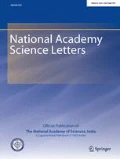Abstract
Outcrossing rates in biodiesel species Pongamia pinnata were estimated using amplified fragment length polymorphism (AFLP) and microsatellite markers. Five AFLP primer combinations and eight pairs of microsatellite primers were used for fingerprinting of 55 open pollinated progenies derived from five mother trees. The multilocus out-crossing rate was quite high with AFLP (0.917; SD = 0.103) and comparatively low with microsatellite markers (0.748; SD = 0.127). The multilocus out-crossing rate was higher than single locus out-crossing rate in case of both marker systems (tm − ts = 0.203; SD = 0.090) which implies that biparental inbreeding occurred at significant levels. The estimated F was higher than the expected which also indicated towards high inbreeding in the progeny population analyzed. This is the first study on estimation of outcrossing rates using any kind of molecular marker systems in Pongamia. We expect an increasing use of such high throughput PCR-based technologies in mating-system studies in various other tree species.


References
Tewari DN (2003) Report of the committee on development of bio-fuel. Planning Commission, Government of India
Scott PT, Pregelj L, Chen N, Hadler JS, Djordjevic MA, Gresshoff PM (2008) Pongamia pinnata: an untapped resource for the biofuels industry of the future. Bioenerg Res 1:2–11
Lakshmikanthan V (1978) Tree borne oil seeds. Directorate of non edible oils and soap industries. Khadi and Village Industries Commission, Mumbai, p 10
Raju AJS, Rao SP (2006) Explosive pollen release and pollination as a function of nectar feeding activity of certain bees in the biodiesel plant, Pongamia pinnata (L.) Pierre (Fabaceae). Curr Sci 90:960–967
Adams WT (1983) Applications of isozymes in tree breeding. Vol. Part A. Elsevier Science Publishers, Amsterdam
Williams JG, Kubelik AR, Livak KJ, Rafalski JA, Tingey SV (1990) DNA polymorphisms amplified by arbitrary primers are useful as genetic markers. Nucl Acids Res 18:6531–6535
Sharma SS, Aadil K, Negi MS, TripathI SB (2014) Efficacy of two dominant marker systems, ISSR and TE-AFLP for assessment of genetic diversity in biodiesel species Pongamia pinnata. Curr Sci 106:1576–1580
Vos P, Hogers R, Bleeker M, Reijans M, van de Lee T, Hornes M, Friters A, Pot J, Paleman J, Kuiper M, Zabeau M (1995) AFLP: a new technique for DNA fingerprinting. Nucl Acids Res 23:4407–4414
Sharma SS, Islam MA, Negi MS, Tripathi SB (2014) Isolation and characterization of a first set of nine polymorphic microsatellite loci in Pongamia pinnata (Fabaceae). J Genet 93:e70–e74
Singh A, Negi MS, Rajagopal J, Bhatia S, Tomar UK, Srivastava PS, Lakshmikumaran M (1999) Assessment of genetic diversity in Azadirachta indica using AFLP markers. Theor Appl Genet 99:272–279
Sharma SS, Negi MS, Sinha P, Kumar K, Tripathi SB (2011) Assessment of genetic diversity of biodiesel species Pongamia pinnata accessions using AFLP and three endonuclease—AFLP. Plant Mol Biol Rep 29:12–18
Schuelke M (2000) An economic method for the fluorescent labelling of PCR fragments. Nat Biotechnol 18:233–234
Shaw DV, Allard R (1982) Estimation of outcrossing rates in Douglas-fir using isozyme markers. Theor Appl Genet 62:113–120
Baye T, Becker HC (2004) Natural out crossing rate in Vernonia galamensis. Plant Breed 123:398–399
Gaiotto FA, Bramucci M, Grattapaglia D (1997) Estimation of outcrossing rate in a breeding population of Eucalyptus urophylla with dominant RAPD and AFLP markers. Theor Appl Genet 95:842–849
Muluvi GM, Sprent JI, Soranzo N, Provan J, Odee D, Folkard G, McNicol JW, Powell W (1999) Amplified fragment length polymorphism (AFLP) analysis of genetic variation in Moringa oleifera Lam. Mol Ecol 8:463–470
Hon-xing RAO, Patterson B, Potts B, Vaillancourt R (2008) A microsatellite study on outcrossing rates and contamination in an Eucalyptus globules breeding arboretum. J For Res 19:136–140
O’Connell LM, Russell J, Ritland K (2004) Fine-scale estimation of outcrossing in western redcedar with microsatellite assay of bulked DNA. Heredity 93:443–449
Borrone JW, Olano CT, Kuhn DN, Brown JS, Schnell RJ, Violi HA (2008) Outcrossing in Florida avocados as measured using microsatellite markers. J Am Soc Hortic Sci 133:255–261
Dhillon RS, Hooda MS, Ahlawat KS, Kumari S (2009) Floral biology and breeding behavior in karanj (Pongamia pinnata). Ind For 135:618–628
Acknowledgements
The authors sincerely acknowledge the funding received from Department of Science and Technology, Government of India, for the Project (Grant Number SR/SO/PS-08/2006). Mr. Shyam Sundar Sharma thanks to Council of Scientific and Industrial Research, Government of India, for providing fellowship for this work.
Funding
The authors sincerely acknowledge the funding received from Department of Science and Technology, Government of India.
Author information
Authors and Affiliations
Corresponding author
Ethics declarations
Conflict of interest
The authors declare that they have no conflict of interest.
Electronic supplementary material
Below is the link to the electronic supplementary material.
Rights and permissions
About this article
Cite this article
Sharma, S.S., Islam, M.A., Negi, M.S. et al. Estimation of Outcrossing Rates in Biodiesel Species Pongamia pinnata Based on AFLP and Microsatellite Markers. Natl. Acad. Sci. Lett. 40, 105–108 (2017). https://doi.org/10.1007/s40009-016-0533-2
Received:
Revised:
Accepted:
Published:
Issue Date:
DOI: https://doi.org/10.1007/s40009-016-0533-2

